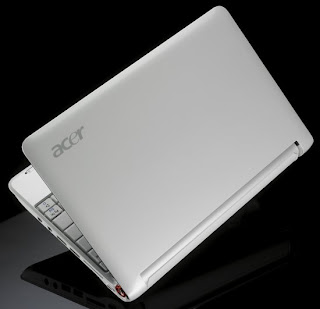Attention to Acer Aspire One user!! 

The SSD HD that comes in the Linux version of the Acer Aspire One has very fast read times, but very slow write times and because of this, some adjustments need to be made to speed up the system under Windows XP. All of these tweaks are very easy to make, and make a huge difference in performance. The key is to keep the system accessing the SSD as infrequently as possible.
As mentioned in a previous post, make sure you formatted the HD with the FAT32 file system and not NTFS. NTFS will be painfully slow on the SSD.
BIOS
The first thing you can do to speed up the system is to disable the “D2D recovery” system in the BIOS (Press F2 at startup to access the BIOS). This feature keeps an extra partition for recovery and takes up drive space and usage. Simply disable it, save and exit to boot back into Windows.
Turn off Paging File
If you’ve upgraded your memory (see below post) to the maximum 1.5GB, then you can turn off the paging file, which will greatly reduce startup time and speed up general usage. I do not recommend doing this though if you have less than 1GB of RAM. To disable the paging file, go to System Properties > Settings (under performance), select the “advanced” tab, then click the Change (under virtual memory) button. Click on the “No paging file” radio button and then click “set” and “apply”. You will have to restart your machine for the changes to take effect.
Turn off visual effects
Windows XP is pretty, but a lot of the shadowing and fading in and out that the system uses takes up a good deal of memory and resources. Turning off all or most of these effects will speed up the system. To adjust the effects, go to System Properties > Settings (under performance) and select the “Adjust for best performance” radio button. This will untick all of the visual effects. Personally, I like the blue bar at the bottom with the green start button, so I indulged and instead selected “custom” and ticked the last box, “Use visual styles on windows and buttons.”
Turn off Unnecessary Programs and Services
A lot of programs like to startup as soon as Windows loads so that they can be accessed more quickly. The problem is that these background programs are taking up memory and other resources, and unless you use these programs often, are usually best turned off to boost overall performance. Check the “Startup” folder in your programs list to make sure that nothing is loading that you don’t need started when Windows starts.
Similarly, you can turn off services that you don’t need. To access the services menu, go to Start > Run and type in “services.msc”. To disable a service, double click the service, and change the drop down menu under “startup type” to “disable.”
Here is a list of services that I’ve disabled on my Acer Aspire One that has increased the speed and doesn’t seem necessary in my instance of Windows:
AlerterBackground Intelligent Transfer ServiceClipbookComputer BrowserError Reporting ServiceHelp and SupportHuman Interface Device AccessIndexing ServiceIPSEC ServicesMessengerNetwork DDENetwork DDE DSDMPerformance Logs and AlertsPortable Media Serial Number ServiceQos RSVPRemote Desktop Help Session ManagerRouting and Remote AccessSecondary LogonTCP/IP NetBIOS HelperUninterruptible Power SupplyWebClientWindows TimeWMI Performance Adapter
All of these services have a detailed description in the window so you can choose to disable more, or less services depending on how you use your machine. If you happen to disable a service that a program needs, it will just fail to load and usually mention that it needs a particular service that you can just re-enable in the services program.
With all of these tweaks, my cold-start time to ready-to-use time went from 65 seconds to 35 seconds which I’m more than happy with. General usage is also noticably improved and makes this a very nice Windows XP machine even with the slower SSD.
As mentioned in a previous post, make sure you formatted the HD with the FAT32 file system and not NTFS. NTFS will be painfully slow on the SSD.
BIOS
The first thing you can do to speed up the system is to disable the “D2D recovery” system in the BIOS (Press F2 at startup to access the BIOS). This feature keeps an extra partition for recovery and takes up drive space and usage. Simply disable it, save and exit to boot back into Windows.
Turn off Paging File
If you’ve upgraded your memory (see below post) to the maximum 1.5GB, then you can turn off the paging file, which will greatly reduce startup time and speed up general usage. I do not recommend doing this though if you have less than 1GB of RAM. To disable the paging file, go to System Properties > Settings (under performance), select the “advanced” tab, then click the Change (under virtual memory) button. Click on the “No paging file” radio button and then click “set” and “apply”. You will have to restart your machine for the changes to take effect.
Turn off visual effects
Windows XP is pretty, but a lot of the shadowing and fading in and out that the system uses takes up a good deal of memory and resources. Turning off all or most of these effects will speed up the system. To adjust the effects, go to System Properties > Settings (under performance) and select the “Adjust for best performance” radio button. This will untick all of the visual effects. Personally, I like the blue bar at the bottom with the green start button, so I indulged and instead selected “custom” and ticked the last box, “Use visual styles on windows and buttons.”
Turn off Unnecessary Programs and Services
A lot of programs like to startup as soon as Windows loads so that they can be accessed more quickly. The problem is that these background programs are taking up memory and other resources, and unless you use these programs often, are usually best turned off to boost overall performance. Check the “Startup” folder in your programs list to make sure that nothing is loading that you don’t need started when Windows starts.
Similarly, you can turn off services that you don’t need. To access the services menu, go to Start > Run and type in “services.msc”. To disable a service, double click the service, and change the drop down menu under “startup type” to “disable.”
Here is a list of services that I’ve disabled on my Acer Aspire One that has increased the speed and doesn’t seem necessary in my instance of Windows:
AlerterBackground Intelligent Transfer ServiceClipbookComputer BrowserError Reporting ServiceHelp and SupportHuman Interface Device AccessIndexing ServiceIPSEC ServicesMessengerNetwork DDENetwork DDE DSDMPerformance Logs and AlertsPortable Media Serial Number ServiceQos RSVPRemote Desktop Help Session ManagerRouting and Remote AccessSecondary LogonTCP/IP NetBIOS HelperUninterruptible Power SupplyWebClientWindows TimeWMI Performance Adapter
All of these services have a detailed description in the window so you can choose to disable more, or less services depending on how you use your machine. If you happen to disable a service that a program needs, it will just fail to load and usually mention that it needs a particular service that you can just re-enable in the services program.
With all of these tweaks, my cold-start time to ready-to-use time went from 65 seconds to 35 seconds which I’m more than happy with. General usage is also noticably improved and makes this a very nice Windows XP machine even with the slower SSD.
Source:aceraspireoneblog.com
*for anyone who use Acer aspire one or other laptop which use Intel Atom, this tips for your XP..
*for anyone who use Acer aspire one or other laptop which use Intel Atom, this tips for your XP..























No comments:
Post a Comment